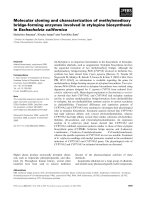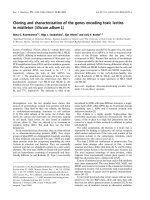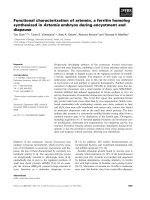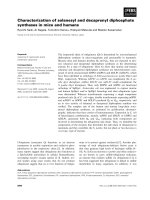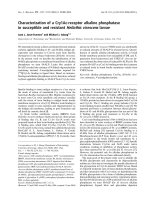Characterization of local pigmented rice genetic resources in vietnam
Bạn đang xem bản rút gọn của tài liệu. Xem và tải ngay bản đầy đủ của tài liệu tại đây (1.86 MB, 57 trang )
VIETNAM NATIONAL UNIVERSITY OF AGRICULTURE
FACULTY OF BIOTECHNOLOGY
UDERGRADUATE THESIS
TITTLE:
CHARACTERIZATION OF LOCAL PIGMENTED
RICE GENETIC RESOURCES IN VIETNAM
Student
: DO THI MINH NGUYET
Faculty
: BIOTECHNOLOGY
Supervisors
: LE DUC THAO, Phd.
NGUYEN QUOC TRUNG, Msc.
Class
: K61CNSHE
Student ID
: 610654
Ha Noi - 2021
COMMITMENTS
I guarantee that all the data and results in this thesis are truthful and have
never been used in any report yet.
I also assure that the information cited in the thesis is indicated the origin
and all the help is thankful.
Hanoi, 30th January , 2021
Student
Do Thi Minh Nguyet
i
ACKNOWLEDGEMENTS
Firstly, I would like to express my appreciation to the directory of
Vietnam National University of Agriculture, board of deans and lectures in
faculty of biotechnology that created the best condition for me to perform and
complete my thesis.
Secondly, I’m deeply indebted to my supervisor, MSc. Nguyen Quoc
Trung Who guided me to conduct experiments, advised me on professional
knowledge. His support pushed me to sharpen my thinking and patience to
accomplish the thesis.
I would also like to thank guides from Crop Research and Development
Institute who helped me building the field layout, shared useful experience in
rice cultivation and the way to measure agronomic characteristics.
I gratefully acknowledge my colleagues in laboratory for their wonderful
assistance. Thank to them I can complete my research and they made me fun
and optimistic.
Last but not least, I would like to thank my parents for encouragement in
study as well as in life. I have never finished my dissertation without their love
and their support.
Hanoi, 30th January , 2021
Student
Do Thi Minh Nguyet
ii
CONTENTS
COMMITMENTS.................................................................................................. i
ACKNOWLEDGEMENTS .................................................................................. ii
CONTENTS .........................................................................................................iii
LIST OF TABLES ................................................................................................ v
LIST OF FIGURES ............................................................................................. vi
LIST OF ABBREVIATIONS ............................................................................. vii
Summary ............................................................................................................viii
CHAPTER 1. INTRODUCTION ......................................................................... 1
1.1. Introduction .................................................................................................... 1
1.2. Objectives ...................................................................................................... 2
1.3. Requirements ................................................................................................. 3
CHAPTER 2. LITERATURE REVIEW .............................................................. 4
2.1. Genetic resources of rice................................................................................ 4
2.1.1. Genetic resources ........................................................................................ 4
2.1.2. Global genetic resources of rice ................................................................. 4
2.1.3. Genetic resources of rice in Vietnam.......................................................... 6
2.1.4. Pigmented rice genetic resources................................................................ 7
2.2. Pigmented rice ............................................................................................... 9
2.2.1. Properties of pigmented rice ....................................................................... 9
2.2.2. Anthocyanin .............................................................................................. 12
2.2.3. The studies about genetic diversity of rice ............................................... 17
CHAPTER 3. MATERIALS AND METHODS ................................................ 20
3.1. Materials ...................................................................................................... 20
3.2. Field layout .................................................................................................. 21
3.2.1. Experimental layout .................................................................................. 21
3.2.2 Cultivation techniques ............................................................................... 22
3.3. Methods........................................................................................................ 23
3.3.1. Agronomical characterization ................................................................... 23
iii
3.3.2. Identification of four genes: kala1, kala3, kala4 and rc........................... 24
3.3.3. Data analysis ............................................................................................. 26
CHAPTER 4. RESULTS AND DISCUSSIONS ............................................... 27
4.1. Agronomical characteristics and yield......................................................... 27
4.1.1. Agronomical characteristics ..................................................................... 27
4.1.2. Grain yield, yield components and yield actual ....................................... 30
4.2. Identification of four genes: kala1, kala3, kala4 and rc.............................. 32
4.2.1. The result of genomic DNA extraction. ................................................... 32
4.2.2. Identification of four genes: kala1, kala3, kala4 and rc........................... 33
CHAPTER 5. CONCLUSIONS AND SUGGESTIONS ................................... 39
5.1. Conclusions .................................................................................................. 39
5.2. Suggestions .................................................................................................. 39
REFERENCES ................................................................................................... 40
APPENDIX ......................................................................................................... 44
iv
LIST OF TABLES
Table 2. 1. The number of pigmented rice accessions collected. .................................. 8
Table 2. 2. Anthocyanin content of some kind of food. .............................................. 15
Table 3. 1. List of 30 colored rice accessions .............................................................. 20
Table 3. 2. Four new SSR markers for 4 genes controlling pigment of pericarp. ....... 26
Table 3. 3. The compositions of PCR .......................................................................... 26
Table 4. 1. Morphological characteristics of the 30 accessions. .................................. 27
Table 4. 2. Grain yield, yield components and yield actual of the 30 local pigmented
rice accessions. ............................................................................................................. 31
Table 4. 3. Classification of color of rice pericarp....................................................... 36
Table 4. 4. Identification and characterization of pigment pericarp of 30 accessions. 37
v
LIST OF FIGURES
Figure 2. 1. Phylogenetic tree of the genus Oryza (Wing et al., 2005).......................... 5
Figure 2. 2. White, red, brown and black rice................................................................ 7
Figure 2. 3. Metabolic pathways for the synthesis of proanthocyanidins and
anthocyanins. (ANR, anthocyanidin reductase; ANS, anthocyanidin synthase; DFR,
dihydroflavonol‐4‐reductase; F3H, flavanone‐3‐hydroxylase; GT, anthocyanidin
glucosyltransferase; LAR, leucoanthocyanidin reductase) (Xie and Dixon, 2005). ... 10
Figure 2. 4. Chemical structures of several anthocyanins in pigmented rice (Deng et
al., 2013)....................................................................................................................... 13
Figure 2. 5.Predominant structural forms of anthocyanins present at different pH
levels (Wrolstad et al., 2001). ...................................................................................... 14
Figure 3. 1. Field layout ............................................................................................... 22
Figure 4. 1. Days to heading (more than 50% emergence of all panicles) .................. 28
Figure 4. 2. Plant height of 30 accessions. ................................................................... 29
Figure 4. 3. The yield of 30 pigmented rice accessions. .............................................. 32
Figure 4. 4. Genomic DNA extracted of 30 accessions. .............................................. 32
Figure 4. 5. The product of primer RM7405................................................................ 33
Figure 4. 6. The product of primer RM3400................................................................ 33
Figure 4. 7.The product of primer RM7210................................................................. 34
Figure 4. 8.The product of qPC7.................................................................................. 34
Figure 4. 9. Color of pericarp of 30 accessions. .......................................................... 35
vi
LIST OF ABBREVIATIONS
Abbreviation
Meaning
bHLH
Basic-helix-loop-helix
CBD
Convention on Biological Diversity
SSRs
Simple sequence repeats
IRGSP
International Rice Genome Sequencing Project
IRRI
International Rice Research Institute
SNP
Single nucleotide polymorphism
ISSR
Inter-simple sequence repeat
RFLP
Restriction fragment length polymorphism
QTL
quantitative trait loci
vii
Summary
Recently, ‘colored rices’ ternminology is used to refer to three types of
rice: Purple Rice, Black Rice, Red Rice that are the seed of the glass species
Oryza sativa L. Black and purple pericarps are the result of accumulation of
anthocyanin, while red pericarps are due to proanthocyanidins (Gunaratne et al.,
2013; Samyor et al., 2017). These natural products are well known for their
beneficial effects on health: anti-oxidative, anti-inflammatory, anti-mutagenic
and anti-carcinogenic properties coupled with their capacity to modulate key
cellular enzyme function (Panche et al., 2016).
In this study, we focused characterization of agronomical characters,
genes controlling pigment in pericarp: kala1, kala3, kala4 and Rc genes of 30
accessions that were collected from different locations in Vietnam. According
to the methods of IRRI (2013), the results showed that the pigmented rice
accessions varied in heading time (62 to 101 days), plant height (85.6 to 153.6
cm). The grain yield of 30 accessions reached from 1.3 to 5.9 t/ha whereas the
yield actual got from 0.7 to 2.5 t/ha. Four genes controlling pigment in pericarp
kala1, kala3, kala4 and Rc were identified by 4 SSR markers (Gu et al., 2011;
McCouch et al., 2002). This study contributes to the efficient exploitability and
cultivation of pigmented rice resources.
Key words: pigmented rice, kala, Rc, yield.
viii
CHAPTER 1. INTRODUCTION
1.1. Introduction
Rice (Oryza sativa L.) is one of the most important food crops
worldwide, being used as the main food source by more than half of the global
population (Mahender et al., 2016). In the developing world, rice provides 27%
of dietary energy and 20% of dietary protein. For Vietnamese people, ordinary,
white rice is main dish and present in all three meal of day. White rice has been
domesticated and preferred since ancient times, so very geneticists find ways to
select white rice varieties. Recently, ‘colored rices’ ternminology is used to
refer to three types of rice: Purple Rice, Black Rice, Red Rice that are the seed
of the glass species Oryza sativa L. Black and purple pericarps are the result of
accumulation of anthocyanin, while red pericarps are due to proanthocyanidins
(Gunaratne et al., 2013; Samyor et al., 2017).
Anthocyanins and proanthocyanidins belonging to plant flavonoids,
contribute to the intense color of many fruits, vegetables, and pigmented
cereals. These natural products are well known for their beneficial effects on
health: anti-oxidative, anti-inflammatory, anti-mutagenic and anti-carcinogenic
properties coupled with their capacity to modulate key cellular enzyme function
(Panche et al., 2016).
The Rc and Rd genes are involved in proanthocyanidin synthesis in rice
pericarp (Furukawa et al., 2007). Interaction of Rc (on chromosome 7), which
encodes a basic helix-loop-helix (bHLH) transcription factor, and Rd
(chromosome 1) encoding a form of dihydroflavonol 4-reductase, an enzyme
which enhances the accumulation of proanthocyanidin (Mbanjo et al., 2020).
The purple pericarp color in rice was controlled by two dominant
complementary genes, Pb and Pp (Rahman et al., 2013). A whole genome
survey of the introgression line using DNA markers suggested that three
1
regions, on chromosomes 1, 3 and 4 are associated with black pigmentation
(Maeda et al., 2014).
In our country, the wild rice species – the ancestor of today’s rice
varieties have all red grains as: Oryza nivara Sharma et Shastry, Oryza
rufipogon Griffith (distributed from North to South, South Central Coast),
Oryza granulata Nees et Arn. ex Watt, Oryza officinalis Wall ex Watt
(distributed in Southeast). The black rices, purple rices such as “Khau Sien Pan”
are grown in some northwest provinces, “Cam Pe” in Thanh Hoa, black rice of
nationalities: Pa Co, Ta Oi, Bru... The directly sowed rices is mainly red rice
varieties as “Nang Rung”, “Nang Tay”, “Nang Tri”, “Nang Dum” that are
grown in the Long Xuyen quadrilateral region. Red rices are also grown in some
ethnic minority areas in the Central region and the Central Highlands such as
“Ra Du” (ordinary rice) of Pa Ko people (in Quang Tri, Hue), red glutinous rice
of Kreng (in Gia Lai). Many local rice varieties are stored and cultivated by
farmers but it’s spontaneous, low yield because of climate change and no
having adequate scientific basic to aid sensible cultivation and due to they have
gradually become extinct. During recent years, local colored rice varieties has
been reinvigorated and hybridize. Some new rice varieties have been planted
such as : DH6, HNOE, DT 128, DT 135, O Me Coc.
This current review has focused on assessment of important agronomical
characteristics, anthocyanin content and four genes controlling the pigment in
pericarp: kala1, kala3, kala4 and Rc genes. This study will contribute to the
efficient exploitability and cultivation of pigmented rice resources.
1.2. Objectives
Characterization of agronomical characteristics, and genes controlling
pigment in pericarp: kala1, kala3, kala4 and Rc.
2
1.3. Requirements
- Characterization of agronomical traits in plant height, heading date,
tiller number, yield components, yield…
- measurement of anthocyanin content of 30 accessions.
- Identification of Rc, Kala1, Kala3, and Kala4 genes in 30 accessions by
DNA markers.
3
CHAPTER 2. LITERATURE REVIEW
2.1. Genetic resources of rice
2.1.1. Genetic resources
Genetic resources means genetic material of actual or potential value ;
genetic material means any material of plant, animal, microbial or other origin
containing functional units of heredity. (CBD, Article 2)
Genetic resources is one of the three levels of Biodiversity defined by the
Convention on Biological Diversity in Rio, 1992:
- Animal genetic resources for food and agriculture
- Forest genetic resources
- Plant genetic resources
The gene pool or genetic material in natural and cultivated stocks of
organisms of actual or potential value that are available for human exploitation.
It is desirable to maintain as diverse a range of organisms as possible,
particularly of domesticated cultivars and their ancestors, in order to maintain a
wide genetic base. The wider the genetic base, the greater the capacity for
adaptation to particular environmental conditions.
2.1.2. Global genetic resources of rice
Rice was first domesticated in Asia as ‘Oryza sativa’, 10,000–15,000
years ago. Nowadays rice is widely planted in more than 120 countries across
the world, mainly in Asia. There are two main cultivated types: Oryza sativa
and O. glaberrima and 22 wild species (Ge et al., 1999). The O. sativa genepool
is now a highly diverse and extends from the Ganges plains below the eastern
foothills of Himalaya, through upper Myanmar, Laos, Thailand and Vietnam, to
southern China. Oryza sativa contains two major subspecies: the sticky, shortgrained japonica or sinica variety, and the nonsticky, long-grained indica rice
variety. Japonica varieties are usually cultivated in dry fields (it is cultivated
mainly submerged in Japan), in temperate East Asia, upland areas of Southeast
4
Asia, and high elevations in South Asia, while indica varieties are mainly
lowland rices, grown mostly submerged, throughout tropical Asia. Five distinct
groups were detected, corresponding to indica, aus, aromatic, temperate
japonica, and tropical japonica rices by analysing nuclear SSRs and two
chloroplast loci (Garris et al., 2005). A second species, O. glaberrima, was
domesticated in West Africa from O. barthii, probably about 3,500 years ago.
Unlike O. sativa, cultivation did not spread outside the region of domestication
and less diverse than O. sativa. The rice genus has ten genometypes (A, B, BC,
C, CD, E, F, G, HJ, and HK). Cultivated rice is classified as an AA genome
diploid and has six wild AA genome relatives. The remaining 15 wild species
are classified into nine other genome types that include both diploid and
tetraploid species.
Figure 2. 1. Phylogenetic tree of the genus Oryza (Wing et al., 2005).
More than 400,000 rice accessions have been collected in the public
germplasm repositories. The large germplasm resources conservation center of
rice includes the International Rice Research Institute (>100,000 rice
accessions), National Crop Genebank of China (>80,000), National Plant
Germplasm System of United States Department of Agriculture (USDA,
5
>18,000), and National Bureau on Plant Genetic Resources of India (>60,000)
(Wei and Huang, 2019). The International Rice Genome Sequencing Project
(IRGSP), established in 1998 which released a high-quality finished genome
sequence of japonica rice (one of two subspecies of rice) in 2005. The public
IRGSP sequence opened the door for functional characterization of the rice
genome and permitted rice geneticists to identify the genes underlying complex
agronomic traits. Basing on the rice genome will benefit understanding of the
biological function of rice genes and the genetic improvement of rice production
and quality.
At present, many scientists have crossed and selected high-yielding
varieties are needed to meet the food demands of everincreasing human
populations, there is a price to pay in terms of loss of genetic diversity or
genetic erosion. In many areas, high-yielding modem varieties were adopted by
farmers and the cultivation of the landrace varieties declined. The wild species
are threatened with extinction through changes in land use, extension of
agriculture into marginal areas, and deforestation. The problems of genetic
erosion are severe, but international efforts to conserve rice genetic resources, in
which IRRI has taken a leading role, have led to the establishment of several
gene banks in Asia. These joint efforts between national, regional, and
international organizations ensure the long-term preservation of the biodiversity
of the rice genepool.
2.1.3. Genetic resources of rice in Vietnam
In Vietnam, as well as other Asia countries the wild rice appeared at least
18000 years ago. Rice is mainly cultivated in two largest deltas of the country,
that are the Red River delta and Mekong River delta. Besides, rice is distributed
in central coastal provinces and northern mountainous provinces. Since 1996,
more than 3000 Vietnamese traditional rice accessions have been collected from
different ecosystems by the national project conducted by National Plant
6
Resource Centre, Vietnam Academy of Agricultural Sciences. Currently,
national plant genebank of Vietnam holds about 7000 samples of rice varieties.
Vietnamese rice resources is appraised rich varietal diversity. North Vietnam is
said to lie within the center of genetic diversity of Asian cultivated rice
(Fukuoka et al., 2003). The Mekong Delta, Vietnam, where the Mekong River
flows out into the East Sea, has been considered a “biological treasure trove.”
This area is also rich in wild rice species such as O. rufipogon, O. nivara, and
O. officinalis (Lam et al., 2019). However, climate change and unresonable
cultivation is the cause of the decline of genetic diversity. In 1963, Vietnam and
IRRI collaborated through that, Vietnamese farmers are now able to maximize
the full potential of the high-yielding rice varieties being grown in the Mekong
and Red River Deltas. Vietnam placed high value on their collaboration with
IRRI. From their initial areas of collaboration, Vietnam and IRRI are expanding
their partnership to include rice production in the upland ecosystem,
environmental issues, and grain quality.
2.1.4. Pigmented rice genetic resources
Most rice cultivars produce grains with white pericarps, but some have
colored pericarps, which can be red, brown, or black (also known as purple).
Figure 2. 2. White, red, brown and black rice.
7
The pericarps of colored rice grains accumulate proanthocyanidin (“red
rice”) or anthocyanin (“black rice”). The red pericarp is natural characteristic of
weedy rice varieties such as Oryza sativa f. spontanea is widely distributed
globally, Oryza rufipogon is native to East, South and Southeast Asia. The
pigmented rice has been cultivated and consumed in Asia including China,
Japan, Korea, and South East Asian countries for a long time and is widely
known as “forbidden rice.” Royal families and kings used to consume these
special varieties of rice in order to have their health improvement and to
enhance their wealth. In addition, many varieties of dark pigmented rice
including Japonica black rice, Chinese black rice, Thai black rice and
Indonesian black rice have been widely studied.
Currently, national plant genebank of Vietnam has stored 1935 pigmented
rice accessions collected from all the country.
Table 2. 1. The number of pigmented rice accessions collected.
Regions
Number of samples
North Central
305
Northeast
421
Red River Delta
171
Southeast
24
South Central Coats
116
Northwest
497
Southwest
32
Introduced
4
Indeterminate
280
Many local pigmented rices are reinvigorated and hybridized. The wild
rice O. rufipogon is demonstrated aluminum tolerance, and some varieties can
resistant to pets, from that many useful accessions have been exploited for rice
improvement over the last few decades, mostly to improve resistance to the
8
brown plant hopper and blast, and tolerance to phosphorus deficiency,
aluminum toxicity and acid sulfate soil (Nguyen et al., 2003).
2.2. Pigmented rice
2.2.1. Properties of pigmented rice
The pigmented rice is distinguished between colours covering the outer
layer of rice grain included red, brown, purple and black rice. The compounds
responsible for these color variations are the flavonoids anthocyanin and
proanthocyanidin, which are known to have nutritional value. Rice ancestors
(Oryza
rufipogon)
accumulate
anthocyanin
in
various
tissues
and
proanthocyanidin in pericarps, but most cultivated rice (Oryza sativa) miss these
flavonoid pigments as a consequence of artificial selection.
The synthesis of the flavonoids is initiated by the deamination of
phenylalanine to form cinnamic acid, a reaction catalyzed by phenylalanine
ammonia lyase. Cinnamate 4-hydroxylase catalyses the oxidation of cinnamic
acid to 4-coumaric acid, which is in turn converted to 4-coumaroyl-CoA
through the action of 4-coumaroyl-CoA ligase (Cheng et al., 2014). Cinnamic
acid is converted to p-coumaroyl-CoA, which affects the synthesis of phenolic
acids, flavanones, proanthocyanidins, and anthocyanidins. The enzymes
catalyse flavonoid biosynthesis including chalcone synthase (CHS), chalcone
isomerase (CHI), flavanone 3‐hydroxylase (F3H), flavonoid 3′ hydroxylase
(F3′H), flavonoid 3′5′ hydroxylase (F3′5′H), flavonol synthase (FLS),
dihydroflavonol 4‐reductase (DFR), anthocyanidin synthase (ANS) or
leucoanthocyanidin dioxygenase (LDOX), UDP‐flavonoid glucosyl transferase
(UFGT), leucoanthocyanidin reductase (LAR) and anthocyanidin reductase
(ANR) (Xu et al., 2015).
9
Figure 2. 3. Metabolic pathways for the synthesis of proanthocyanidins and
anthocyanins. (ANR, anthocyanidin reductase; ANS, anthocyanidin synthase;
DFR, dihydroflavonol‐4‐reductase; F3H, flavanone‐3‐hydroxylase; GT,
anthocyanidin glucosyltransferase; LAR, leucoanthocyanidin reductase) (Xie and
Dixon, 2005).
The biosynthesis of anthocyanins is mediated by multiple enzymes, and
their coding genes are early and late biosynthesis genes, whose regulation is
coordinated by discrete phytohormone signalling pathways through their actions
on a subgroup of R2-R3 MYB, bHLH and WD40 domain-containing
transcription factors. Early biosynthetic genes, such as chalcone synthase
(CHS), chalcone isomerase (CHI), flavone 3-hydroxylase (F3H), flavonoid 3′hydroxylase (F3′H) and flavonol synthase (FLS), are preferentially activated by
R2R3-MYB regulatory genes, such as MYB11, MYB12 and MYB111. In contrast,
late biosynthesis genes, including dihydroflavonol 4-reductase (DFR),
leucoanthocyanidin dioxygenase (LDOX), and UDP-glucose: flavonoid 3Oglucosyl transferase (UF3GT), are primarily regulated by a MYB-bHLHWD40 (MBW) transcription complex, a ternary transcriptional factor complex
10
consisting of R2R3 MYB-activators, bHLH activators and the WD-repeat
protein TTG1 (Kumar et al., 2019). The R2R3‐MYB gene OsC1 is the
determinant factor of anthocyanin biosynthesis in leaf sheath and apiculus (Chin
et al., 2016). A bHLH transcription factor is encoded by Kala4 (chromosome 4)
corresponding to OSB2. OSB2 regulates a number of genes encoding enzymes
involved in anthocyanin synthesis, including F3H, DFR, and ANS led to
expression in the pericarp. Kala1 (chromosome 1) has A1 is a dihydroflavonol
reductase gene involved in anthocyanin synthesis. The presence of C1 (OsC1),
S1 (i.e. OsB2) and A1 (i.e. OsDFR) determines anthocyanin pigmentation in rice
hull (Sun et al., 2018). Carriers of the three loci Kala1 (chromosome 1), Kala3
(chromosome 3), and Kala4 (chromosome 4) express a black pericarp trait
(Maeda et al., 2014). In other demonstration, the dominant complementary
genes Pb (synonym Prp-b) and Pp (synonym Prp-a) on chromosomes 4 and 1
respectively that is responsible for the accumulation of pigment in the pericarp
of purple grain. If rice contains Pp gene and lacks Pb gene, pericarp of rice is
white. While the product of Pb appears to be responsible for the accumulation
of pigment in the pericarp of brown grain, because Pb locus includes two genes,
a myc transcription factor (Ra), along with bHLH16. The bHLH16 has been
shown to be involved in proanthocyanidin synthesis, while Ra is involved in
anthocyanin synthesis. Two loci have been identified using classical genetic
analysis, Rc (brown pericarp and seed coat) and Rd (red pericarp and seed coat).
When present together, these loci produce red seed color. Rc in the absence of
Rd produces brown seeds, whereas Rd alone has no phenotype. The three
common Rc alleles are the wild type Rc, and mutant alleles Rc-s and rc. Rc-s
differs from Rc due to the presence of a premature stop codon, while rc lacks a
14 bp stretch of the wild type sequence. Carriers of rc produce a colorless
pericarp, while those of Rc-s produce a range of pericarp pigmentation
(Sweeney et al., 2007).
11
The pigmented rice has been consumed in China, Japan, and Korea for a
long time. It has been used for strengthening kidney function, treating anemia,
promoting blood circulation, removing blood stasis, treating diabetes, and
ameliorating sight in traditional Chinese medicine. It contains a variety of
flavones, tannin, phenolics, sterols, tocols, γ-oryzanols, amino acids, and
essential oils. Certain pigmented rice varieties are still used to treat skin
diseases, blood pressure, fever, paralysis, rheumatism, and leucorrhea, and even
as the basis of a general health tonic. In the Philippines, “tiki tiki,” derived from
rice bran, has been used to cure thiamine deficiency. In India, the grain of
pigmented rice landraces is offered to lactating mothers, and is used to both
treat jaundice and cure paralysis. A number of scientifically studies have
provided evidence that pigmented rice grain possesses anti-oxidant, antidiabetic, anti-hyperlipidemic, and anti-cancer activity. In addition, the extracts
from pigmented rice are used as natural food colorants in bread, ice cream, and
liquor as well as functional food.
2.2.2. Anthocyanin
Anthocyanins (also anthocyans; from Greek: (anthos) "flower" and
kyaneos/kyanous "dark blue") are water-soluble vacuolar pigments that,
depending on their pH, may appear red, purple, blue or black. Food plants rich
in anthocyanins include the blueberry, raspberry, black rice, and black soybean,
among many others that are red, blue, purple, or black. They occur in all tissues
of higher plants, including leaves, stems, roots, flowers, and fruits. In flowers,
the coloration that is provided by anthocyanin accumulation may attract a wide
variety of animal pollinators, while in fruits, the same coloration may aid in
seed dispersal by attracting herbivorous animals. Anthocyanins may have a
protective role in plants against extreme temperatures with anthocyanins
countering reactive oxygen species. The antioxidant capacity of anthocyanin
12
leads to delay over-ripening processes of fruit and tissues recover faster from
oxidative stress caused by mechanical injury.
Anthocyanins are a group of reddish to purple flavonoids, and are thought
as the primary functional components of colored rice. Anthocyanins are derived
from anthocyanidins by adding sugars. Several anthocyanins have been isolated
and identified from colored rice, including cyanidin 3-glucoside, cyanidin 3galactoside, cyanidin 3-rutinoside, cyanidin 3,5-diglucoside, malvidin 3galactoside, peonidin 3-glucoside, and pelargonidin 3,5-diglucoside. The
structure of anthocyanins is illustrated below:
Figure 2. 4. Chemical structures of several anthocyanins in pigmented rice (Deng
et al., 2013).
The anthocyanins, anthocyanidins with sugar group(s), are mostly 3glucosides of the anthocyanidins. The anthocyanins are subdivided into the
sugar-free anthocyanidin aglycones and the anthocyanin glycosides. The
difference in chemical structure that occurs in response to changes in pH, is the
reason why anthocyanins often are used as pH indicators, as they change from
red in acids to blue in bases through a process called halochromism. They are
13
red or pink in acidic solutions (pH < 7), purple in neutral solutions (pH ≈ 7),
greenish-yellow in alkaline solutions (pH > 7), and colorless in very alkaline
solutions, where the pigment is completely reduced. Most of the anthocyanin
pigments have a high stability in acidic conditions compared with bases, and
degradation occurs at higher pH. Cyanidin and delphinidin are the examples of
anthocyanidin which is stable in acidic condition.
Figure 2. 5.Predominant structural forms of anthocyanins present at different
pH levels (Wrolstad et al., 2001).
Plants rich in anthocyanins are Vaccinium species, such as blueberry,
cranberry, and bilberry; Rubus berries, including black raspberry, red raspberry,
and blackberry; blackcurrant, cherry, eggplant (aubergine) peel, black rice, ube,
Okinawan sweet potato, Concord grape, muscadine grape, red cabbage, and
violet petals. Red-fleshed peaches and apples contain anthocyanins.
Anthocyanins are less abundant in banana, asparagus, pea, fennel, pear, and
14
potato, and may be totally absent in certain cultivars of green gooseberries. The
highest recorded amount appears to be specifically in the seed coat of black
soybean (Glycine max L. Merr.) containing approximately 2 g per 100 g, in
purple corn kernels and husks, and in the skins and pulp of black chokeberry
(Aronia melanocarpa L).
Table 2. 2. Anthocyanin content of some kind of food.
Food sources
Anthocyanin content in mg per 100g
Black raspberry
589
Wild blueberry
558
Cherry
122
Redcurrant
80-420
Black rice
60
Black bean
213
Blue corn (maize)
71
Commercial applications of anthocyanins as food colorants include soft
drinks, fruit preserves (jams, canned fruit), sugar confectionary (jellies), dairy
products (essentially yogurts), dry mixes (acid dessert mixes and drink powders)
and more rarely frozen products (ice cream) and few alcoholic drinks. These
pigments are the natural colorants with low to no toxicity. Natural colorants are
somehow safe to be consumed even at higher doses compared to synthetic
colorants. Anthocyanins are a class of compounds with antioxidant effects. In
addition to acting as antioxidants and fighting free radicals, anthocyanins may
offer anti-inflammatory, anti-viral, and anti-cancer benefits. In herbal medicine,
anthocyanin-rich substances have long been used to treat a number of conditions
involving blood vessel health, including chronic venous insufficiency, high
blood pressure, and diabetic retinopathy. They have also been used to treat a
15
number of other conditions, including colds and urinary tract infections. Recent
research also suggests that anthocyanins may help fend off major health
problems, including heart disease and cancer.
With the above benefits, recently, the scientists have studied a lot about
anthocyanin in many different kind of food and plants. For example, the role of
anthocyanidins and anthocyanins as natural food colorants and their
nutraceutical properties for health that was studied by Hock Eng Khoo et al
(2017). A other research is identification of anthocyanin content, antioxidant,
anti-inflammatory and anticancer properties of blackberry and raspberry fruits
by Camille S. Bowen-Forbes; Yanjun Zhang; Muraleedharan G. Nair (2010).
The extraction of total flavonoids, anthocyanins and phenolics, as well as the
antioxidant activity of black rice (Oryza sativa) and to study the stability in
relation to pH, light and copigmentation is given by Alessandra Cristina Pedro
et al (2016). Some analyses of biosynthesis anthocyanin and genes involved in
accumulating anthocyanin have also explored. A report about biosynthesis of
plant pigments: anthocyanins, betalains and carotenoids is given by Yoshikazu
Tanaka et al (2008). M A Hanson et al analyzed regulatory and enzymatic genes
in the maize anthocyanin pathway as related to the evolution of anthocyaninpigmented kernels in maize from colorless kernels of its progenitor, teosinte
(1996). For pigmented rice, there are many scientific articles related to the
biosynthesis anthocyanin also publicized. A number of attempts have been
made to exploit the quantitative trait loci (QTL) mapping approach as a means
of inferring the genetic basis of grain pigmentation. Rc and Rd genes on
chromosome 7 and 1, respectively were found to associate with degree of red
coloration (DRC) in pericarp of rice through the QTL mapping approach by
Dong Y. et al (2008). Maeda H et al researched in genetic dissection of black
grain rice by the development of a near isogenic line (2014)…
16



